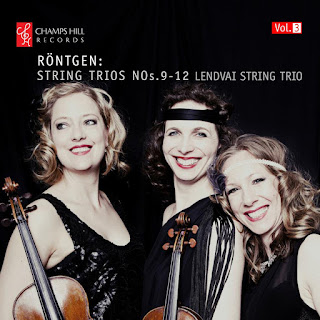The composer, Julius
Röntgen (1855-1932) www.juliusrontgen.nl
was born in Leipzig, Germany to a family
of musicians. His Dutch born father was first violinist in the Gewandhaus
orchestra and his mother was a pianist. He studied composition in Leipzig with Franz
Lachner (1803-1890) and piano with Louis Plaidy (1810-1874) and Carl Reinecke
(1824-1910). He returned to his native Holland to become a piano teacher and help
to found the Amsterdamsch Conservatorium as well as being active as a
recitalist and conductor.
Röntgen’s wrote over 600 compositions including symphonies,
concertos, chamber music in various settings, songs, works for choir and
operas.
It is Röntgen’s
sixteen works for String Trio that the Lendvai String Trio (Dutch violinist
Nadia Wijzenbeek, Swedish violist Ylvali Zilliacus and British cellist Marie
Macleod) http://lendvaistringtrio.com are recording
for Champs Hill Records www.champshillrecords.co.uk
. Their third volume in this series,
that features String Trios, No’s 9 to 12, has just been released.
 |
| CHRCD 101 |
The String Trios date from between 1915 and 1930 and are,
therefore, mature works. The Trio No. 9
in A flat major was written in the spring of 1923 and opens with a light
and good natured Un poco animato that
is developed most beautifully by the Lendvai String Trio. They bring a real
sense of joy to this beguiling music with a finely blended texture of
instrumental sounds, adding a brief moment of intensity before the coda is
reached.
In the Moderato con sentimento
the violin brings a flowing melody over pizzicato viola and cello before the
instrumentalists weave the melody together. There is a livelier, more incisive
central Intermezzo before the music
winds its way to its gently wistful conclusion.
This trio bring a fine swirl of string sound to the more
turbulent Allegro energico adding
much to the dynamic contrasts in wonderfully rich playing, finding all the little
changes in rhythm.
Röntgen’s Trio No. 10
in F minor was written in the summer of 1923 whilst the composer was
staying at his favourite holiday destination of Fuglsang in Denmark. A sudden
string motif is sounded and reflected across the trio as the Allegro molto opens. The idea is
developed through some fine flowing passages which are still interrupted by
more incisive, dynamic phrases. The music rises through some wonderfully
distinctive passages, played with warmth and richness with these players
bringing such fine variety of texture and sonorities. There are lovely little
pizzicato details as well as some finely played faster sections that lead to
the coda.
With the Andante,
a sonorous unison opening statement is gently developed through passages of
shimmering string luminosity before a thoughtful passage with a rising motif arrives.
Later there is a lovely passage where the violin rises passionately over the
viola and cello before a gentle coda.
The viola brings a wistful opening statement in the Allegretto affettuoso, soon joined by
the other players. Despite its outwardly sunny disposition there is a more
intense edge revealed by the Lendvai String Trio. They lift the music with a
fine, light rhythmic touch before speeding towards the coda which arrives full
of light-hearted joy.
Trio No. 11 in G minor
was written within the same ten day period at the beginning of 1925 that
also saw the composition of Trio No. 12 in A major. The Lendvai String Trio brings
an attractive flow to the opening of the Moderato
before pointing up the dynamic contrasts. These players have a fine way of
bringing an unstoppable flow of invention to this music as they move through
passages of deeper, more intense, richer sonorities, finding every little
dynamic, rhythmic and textural detail. There are passages with a gentler
dancing sonority before the lovely coda.
The lithe, rhythmic Vivace
e giocoso fairly sparkles with good humour, with its staccato phrases. This
Trio bring such fine, intuitive accuracy and a lovely crispness to their
playing before a bright and breezy coda.
The Andante con moto
achieves a fine contrast with its broad, flowing, richly toned sonority, bringing
a great sense of freedom and spontaneity as these players move through Röntgen’s
ever changing, whimsical ideas, full of endless invention to the decisive coda.
The Allegro assai
of the Trio No. 12 in A major opens
with a decisive statement before finding a forward flow with these players
weaving a lovely theme. Again Röntgen brings rather whimsical ideas, to which
this Trio responds brilliantly before pizzicato strings bring about the coda.
A gentle little theme opens the Pastorale. Andante tranquillo with the Lendvai String Trio bringing
lovely textures and a real lift to this short movement – quite lovely. They
bring a fine forward flow to the Menuetto
affettuoso with a fine blending of textures, rising to moments of
joyousness before finding the way to a gentle coda on a simple chord.
The Allegro non troppo
leaps up, full of energy and fast moving phrases, with this Trio bringing brilliantly
intense and accurate playing. There is a fine overlay of musical strands as the
music develops through some vibrant passages that positively glow before
arriving at a joyous coda.
These are immensely rewarding works and performances that
will bring delight to listeners. Such are the attractions that I intend to seek
out previous releases in this fine series. The Lendvai String Trio brings much
understanding to this unjustly neglected music. They receive an excellent,
spacious recording from the Music Room, Champs Hill, West Sussex, UK and there
are excellent booklet notes.

No comments:
Post a Comment